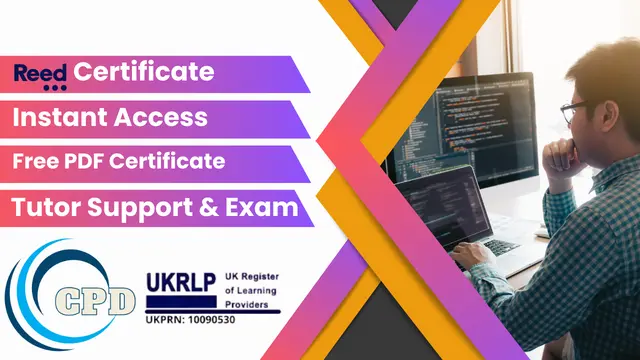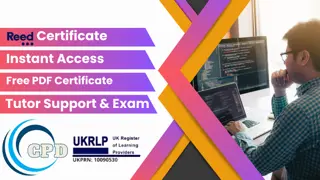
Python: From Data Types to Numpy, Pandas & Career - CPD Certified
Learn Programming in Python | CPD Accredited Provider | Easy Refund Policy | Lifetime Access
Learndrive
Summary
- Reed courses certificate of completion - Free
- Tutor is available to students
Add to basket or enquire
Overview
Embark on a journey of programming excellence with our comprehensive Python Programming course. From mastering the basics to diving deep into Python scripting and libraries, we've designed this course to make you a proficient Python developer. Explore the world of data with NumPy and Pandas, and unlock exciting career opportunities in Python programming. Start your coding adventure today with our Python course.
Learning Outcomes of this Python Programming Course:
- Apply fundamental Python programming concepts.
- Utilize Python basic data types like strings, numbers, and lists.
- Manage data structures using Python operators.
- Employ advanced Python data types such as dictionaries and sets.
- Create logical algorithms with "Python Control Flow" concepts.
- Develop reusable code with Python functions.
- Implement error handling and user input in Python.
- Use advanced Python functions, including lambda and decorators.
- Leverage Python libraries for scripting and data analysis.
- Analyze data efficiently with NumPy and Pandas in Python.
Curriculum
-
Python Programming from A-Z 52:11
-
Getting Familiar with Python 1:15:05
-
Python Basic Data Types 1:31:27
-
Python Operators 53:35
-
Python Advanced Data Types 46:55
-
Python Control Flow Part 1 57:14
-
Python Control Flow Part 2 31:03
-
Python Functions 29:41
-
User Input and Error Handling 41:05
-
Python Advanced Functions 1:04:12
-
Python Scripting and Libraries 1:08:39
-
Numpy 58:06
-
Pandas 1:30:20
-
Intro To OOP 41:01
-
Advanced OOP 1:15:07
-
Starting a Career in Python 1:05:22
Course media
Description
Explore the captivating world of Python programming with our comprehensive Python course. Whether you're a novice eager to grasp the fundamentals or an aspiring data analyst aiming to master Python libraries like NumPy and Pandas, our course is tailored to your Python learning journey. Don't miss this chance to boost your career prospects and embark on a fulfilling path in the realm of Python programming today!
Who is this course for?
This Course is suitable for anyone interested to further progress there career in:
- Level 1 Award in Introduction to Python Programming
- Level 2 Award in Python Programming
- Level 3 Award in Python Programming
- Level 2 Certificate in Python Programming
- Level 3 Certificate in Python Programming
- Level 2 Diploma in Python Programming
- Level 3 Diploma in Python Programming
- Level 4 Certificate in Python Programming
- Level 4 Diploma in Python Programming
- Level 5 Certificate in Python Programming
- Level 5 Diploma in Python Programming
- Level 6 Certificate in Python Programming
- Level 6 Diploma in Python Programming
- Level 7 Certificate in Python Programming
- Level 7 Diploma in Python Programming
- Level 8 Certificate in Python Programming
- Level 8 Diploma in Python Programming
Requirements
This Python Program does not have any prerequisites or formal requirements.
Career path
Taking Python Program Course will open up a variety of career options for you.
- Python Machine Learning Engineer
- Python Data Scientist
- Python Developer
- Python Data Analyst
- Software Engineer
- Software Developer
Questions and answers
will this course able me to create basic data sets in python to export into tensorart via .ckpt .pt .safetensors .ph file format kind regards Simon
Answer:Yes, this Python Course covers various basic data types. Watch the course preview videos to learn more.
This was helpful.
Certificates
Reed courses certificate of completion
Digital certificate - Included
Will be downloadable when all lectures have been completed
Reviews
Currently there are no reviews for this course. Be the first to leave a review.
Legal information
This course is advertised on reed.co.uk by the Course Provider, whose terms and conditions apply. Purchases are made directly from the Course Provider, and as such, content and materials are supplied by the Course Provider directly. Reed is acting as agent and not reseller in relation to this course. Reed's only responsibility is to facilitate your payment for the course. It is your responsibility to review and agree to the Course Provider's terms and conditions and satisfy yourself as to the suitability of the course you intend to purchase. Reed will not have any responsibility for the content of the course and/or associated materials.


